| |
|
Tom Lee
Mott Street’s On Leong Tong leader
Chinatown was led by
Tommy Lee the head of the On Leong Tong from Mott Street. In
Chinatown the On Leong Tong members use Smith Wesson guns while the Hip
Sing Tong members use Colts, so people know who has done the shootings.
|
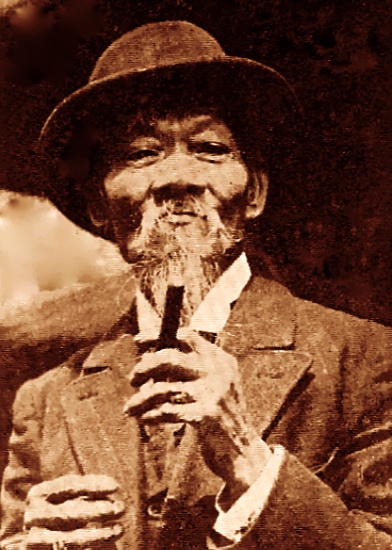 |
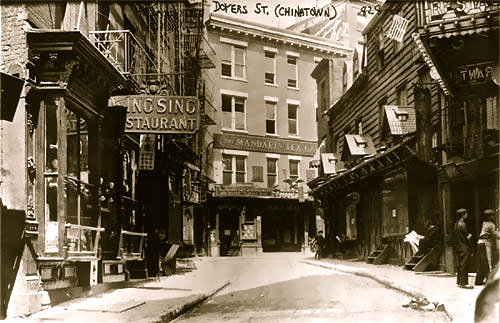
Doyers Street "Bloody Angle" - circa 1900
Chinatown's chief murderous ambush location by the Tongs |
|
A
"Tong War "
in 1909 New York Chinatown, was
caused by the murder of little
Sweet Flower, otherwise
Bow Kum, a slave
girl who had been sold by her father in Canton for a few dollars and
brought to the United States, where she brought three thousand dollars
in the open market in San Francisco. Low Hee Tong, high in the councils
of the Four Brothers and their allies the Hip Sings, was the purchaser,
who lived with the girl for four years.
Then Low Hee Tong got into trouble with the police, and when he could
not produce a marriage license
Bow Kum
was taken away from him and put
in a Christian mission to be saved from sin. Then came Tchin Len, an
industrious truck gardener, who married her and brought her to New York.
Low Hee Tong pressed Tchin Len to return the money which he had invested
in the girl, but the gardener refused to pay, whereupon Low Hee Tong set
forth his grievances in a letter to the Four Brothers and Hip Sings in
New York. His tong leaders felt that the claim was justified, and in his
behalf made solemn demand upon the On Leong Tong, of which Tchin Len was
a member.
The On Leongs ignored the demand, and the Four Brothers and Hip Sings
immediately broke out the red flag of the highbinder from the tong
houses in Pell street and declared war in posters of violent hue
emblazoned upon the billboards. A few days later, on August 15, 1909, a
hatchet man slipped into the home of Tchin Len at No. 17 Mott street and
stabbed
Bow Kum
to the heart, also cutting off her fingers and slashing
her innumerable times across the body.
Then the killing began. This was probably the most disastrous
war the
tongs ever fought in New York, with a casualty list of about fifty dead
and several times that number wounded, and with considerable destruction
of property by bombs, for by that time the Chinese had begun to
experiment with dynamite and the results were fearful.
A failed truce of late 1910, brokered by the Chinese
Minister in Washington, saw it's end when the Wui Saw Tong appeared in
Chinatown and declared war on both the On Leongs and the Hip Sings, who
both vowed the Four Brothers Tong had fomented the disturbance. And so,
the ancient rivals combined forces to exterminate the upstart Wui Saw
Tong.
But the Chinese government again intervened, and with the aid of the New
York police compelled the tongs to agree to a new treaty. It was signed
on May 22, 1913, by the Chinese Merchants Association, the On Leong
Tong, the Hip Sing Tong, and the Kim Lan Wui Saw Tong, but not by the
obstinate Four Brothers Tong. |
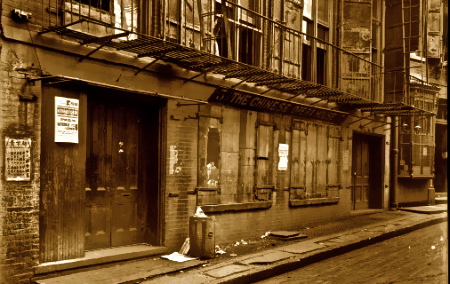 |
Comedian Caught in Chinatown’s
Tong Wars
In 1909, Chinese-American comedian Ah Foon was a
well-known actor, performing regularly at the Chinese Theater. Located
at 5-7 Doyers Street (pictured in 1909 on left), the theater was a popular
venue for Chinese- and English-speaking audiences, who enjoyed the trip
to exotic Chinatown.
Ah Foon belonged to the On Leong Tong, and he had a habit of making jabs
at rival Tongs the Four Brothers and the Hip Sings while on stage.
Bad timing. A Tong war had just broken out, and rival Tong leaders
didn’t like the jabs. So they decided Ah Foon had to be killed. They
warned him of his fate and even told him which day would be his
last—December 30.
Ah Foon took them seriously. He had a police presence on stage with him
at the Chinese Theater that night, and he escaped to his nearby
boardinghouse through a tunnel. On Leong members guarded the
boardinghouse entrance.
Still, he was found shot in the heart the next day in his room. How did
the rival Tongs get in? Apparently they lowered a gang member on a
boatswain’s chair off the roof and into a window in Ah Foon’s room. He
murdered the comedian using a silencer. |
|
Chinese Tongs
The tongs are as American as chop suey, which is said to
have been invented by an American dishwasher in a San Francisco
restaurant. The first tong was organized in the Western gold fields
about 1860, and they played a major roll amongst the Chinese immigrants
working on the railroads, which were opening up the American Western
frontier.
Originally, in the United States, life within the
Chinese communities was dominated by a few large family and district
associations with restrictive membership. As a protective response by
the Chinese people to their dominance, mutual aid associations,
so-called tongs, emerged.
The tongs adopted the norms, values and traditions of the Secret
Societies, and usually were connected at the top to the "Hung" or the "Ching"
Societies. Secrecy within Chinese culture is deeply layered. The tongs
secretive nature, combined with the fact that they could recruit members
without traditional restrictions, enabled them great power compared to
the family and district associations.
"Tong" literally means meeting place. A coming together for a purpose. A
tong is not a criminal organization per se, but a natural means of
obtaining and supplying mutually agreed services. It could be for both
criminal and/or non-criminal purposes. Not all tongs have criminal
dealings nor intent. |
|
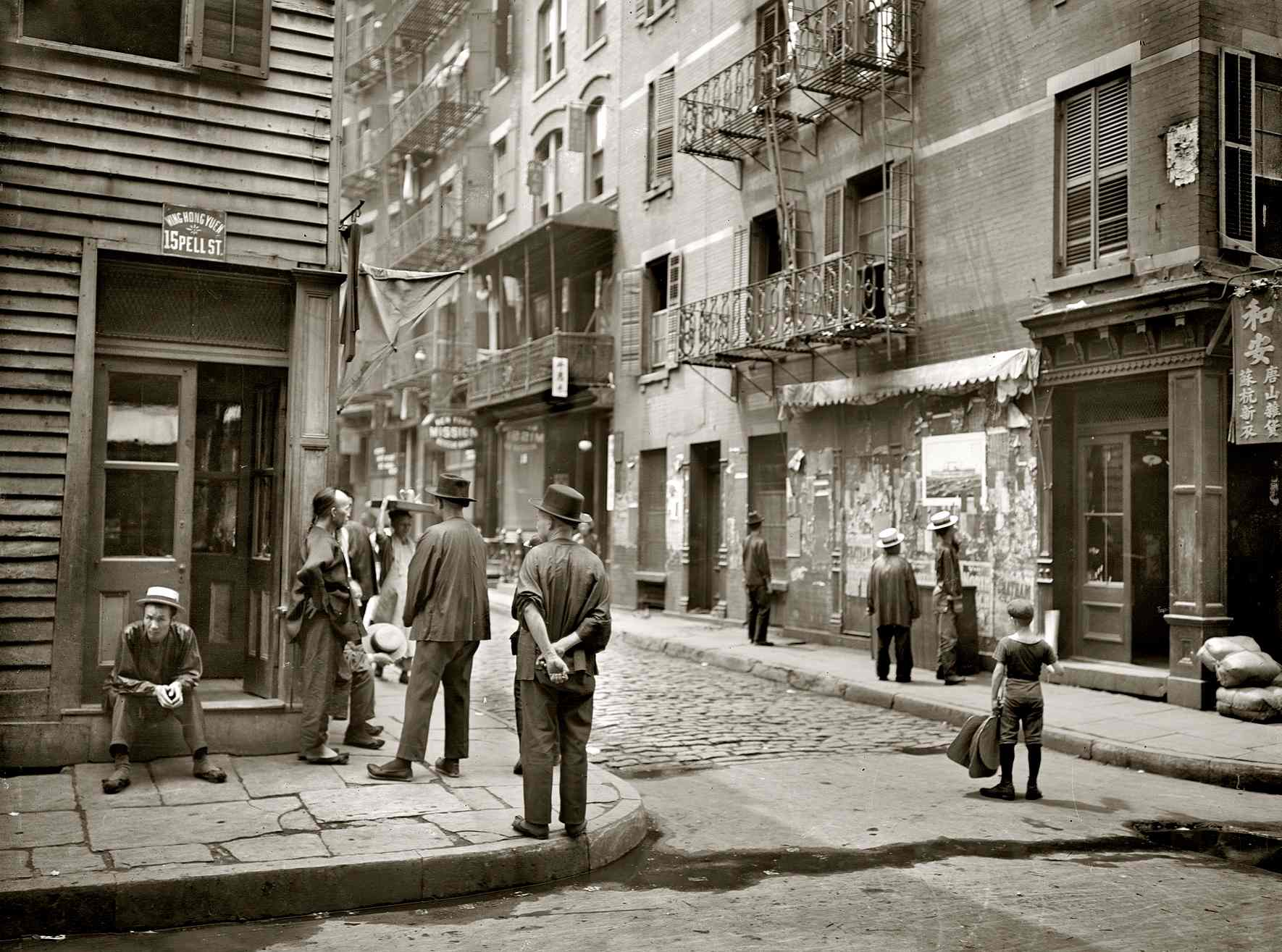
Intersection of Pell and Doyers St. - circa 1900 |
|
Archeologists Probe Secret Tunnels
Coursing Underneath Chinatown |
|
Fresno, California - Tunnels run
beneath Chinatown: Brick-walled passages that were once home to people
and activities that couldn't be mentioned aboveground |
|
The approximately six blocks just west of the
railroad tracks that make up the historic Chinatown were Fresno's
birthplace |
| Fresno's Chinatown before World War II sported the most
vibrant nightlife in Fresno. If you wanted a night out on the town, a
drink, a meal, a gamble, a dance or to meet a girl, you went to
Chinatown. Restaurants operated 24 hours a day, as did the gambling
houses. China Alley, behind modern day Central Fish, was particularly
active. There was a business doorway every 12 feet and often more
businesses behind or below them. Numbers and lottery games were
available at many establishments. This lasted until the late 1950s as
the redevelopment of the 1960s took hold and displaced long-time
residents and businesses; and much of the history was buried. |
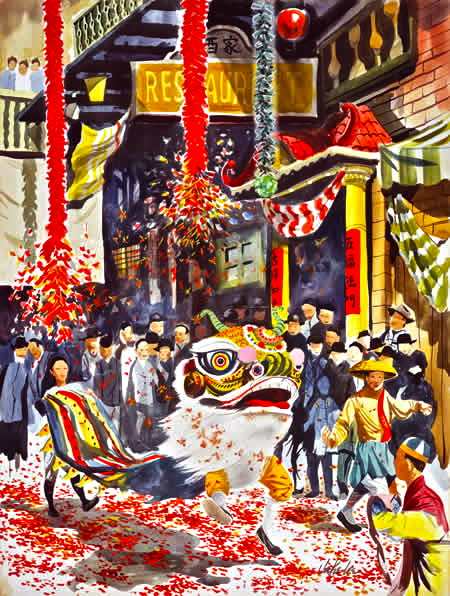 |
Generations of Fresno residents have heard stories about the
mysterious underground world of Fresno's 19th century Chinatown. Was it
a world of illicit activity, with a network of subterranean tunnels?
One of the persistent notions in Chinatown during its boom was that if
someone was murdered in Chinatown, there would be no investigation. What
happened in Chinatown stayed in Chinatown. The mayor, city councilors,
policemen and respectable business people could enjoy a little vice
before going home on the other side of the tracks. Respectable North
Fresno came to Chinatown to play on the West Side. Local lore holds,
that a tunnel one time extended beyond the railroad tracks into the
traditionally white part of town, possibly allowing "respectable"
citizens access to the illicit charms of Chinatown.
Many establishments had basements, some of them interconnected. Of those
that can still be seen today, some end in bricked-off walls that
longtime residents say hide tunnel entrances. In these Chinatown
basements are rooms that are locked that have peep holes. So clearly
there was some fun going on down there. Another story is of seeing
Chinese women dressed in gorgeous clothes going down in one area and
popping up somewhere else. Clearly there was a whole underground world
here that was rich, nefarious, all of those things together. The tunnels
may have been built to provide cool underground storage in a region
known for sweltering summer heat. But they later proved handy for
communication, transportation, and even escape when necessary.
Each basement and passage had a purpose, and after 135 years most are
long forgotten. Fresno's urban legends about underground criminals,
brothels, opium dens and stories of ghosts wandering underground
persist. And yes, anything could and probably did happen underground and
out of sight. |
| Competing Tongs, Chinese Labor Organizations, often fought over work
for their members and underground access points became ways to escape.
Tong antagonisms existed in China and overflowed into the new
communities. There are several newspaper reports about Tong conflicts in
the 1920s in Chinatown, but even the newspaper reported very little on
the activities of Chinatown.
Rick Lew walked the passages as a child, entering through a trapdoor
in his grandfather's liquor store. "There was a nightlife you couldn't
see from the streets," he said. As late as the 1950s, when Lew was a
boy, Chinatown was still thriving - both its respectable establishments
and as its shadier side.
He remembers visiting the underground world with his father, first
passing though a dark basement before descending into a lit tunnel with
an arched roof and enough space for two people to pass by each other.
There were people there he recognized from the neighborhood. And then
there were the glamorous women whose images remain seared in his memory
decades later.
Archeologists are currently using ground-penetrating radar to find
evidence of the secret passages, which are believed to branch out from
long-abandoned basements littered with animal and human waste, cobwebs
and other filth. The project, funded by the city and headed by a group
working to preserve Chinatown, will take data gathered via radar and
compare the findings to the memories of those who recall the
neighborhood's heyday. That will help archeologists decide where to dig
trenches and look for the passages. |
|
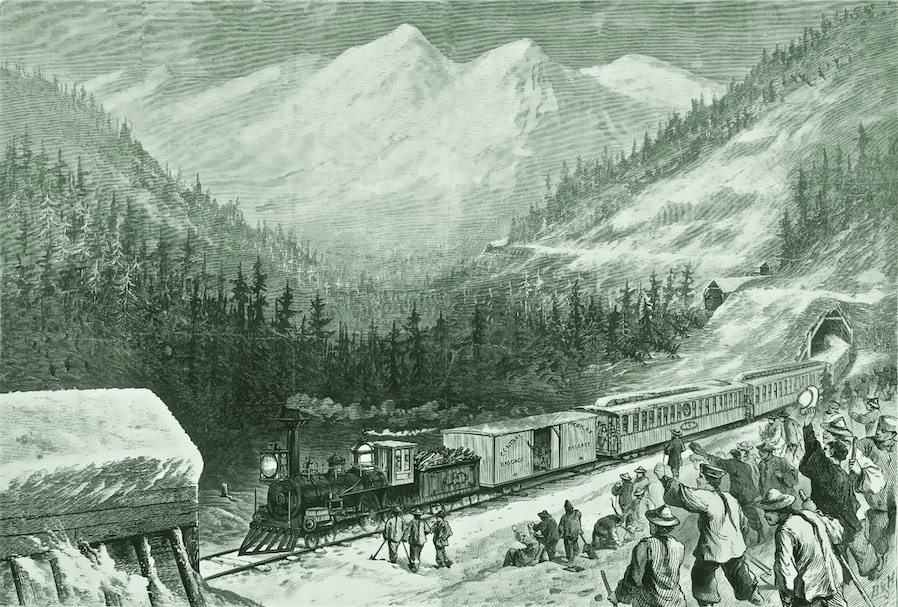 |
|
Chinese Workers on the Railroad |
Throughout California in the gold rush there are lots of stories of
tunnels, connected with the Chinese. The first Chinese who came to the
Fresno area came looking for the "Golden Mountain", mining the
rivers and dry creeks for loose gold to take home to China. They came
before the railroads and they had settlements along the "sinks of Dry
Creek" when the railroad came through and named a new stop "Fresno".
As the gold dreams played out, Chinese workers went to work on railroads
and created other businesses such as laundries, saloons, stores and a
small community grew. In Fresno the community was on the West Side, the
area west of the Southern Pacific railroad tracks. The first buildings
were made of wood. It was customary to dig cellars and basements to
store things and to escape the dry heat of Fresno. Outside steps to them
were built. Sometimes passageways were dug between them in the hard-pan
dirt of Fresno to afford easy access to the neighbors. Sometimes a
business expanded and wanted easy passage, and sometimes they were built
for a quick escape from assailants. The Chinese were not embraced as
citizens when they first arrived and there are many recorded instances
of abusive treatment and false accusations. The ability to duck into a
basement and come out in the alley was a matter of survival. |
|

| One such entity is the quasi-mythical Green Dragon Society (GDS),
also known as the Order of the Green Dragon or simply the Green Dragon. It most
often is mentioned as a Japanese secret society, but that is not necessarily the
whole story. Other evidence, or at least allegation, argues that its true
origins lay in China or Tibet and that its influence extended to the power
centres of Tsarist Russia and Nazi Germany. Historical figures from the Emperor
Hirohito, to Adolf Hitler to Rasputin have been tied to the Green Dragon,
legitimately or not. |
|
|
Shanghai 1920 Chiang Kai-shek's control of Shanghai was made possible with the
aid of two main groups: the wealthy and the criminal. Wealthy
merchants and foreign capitalists supported the KMT with the
understanding that there would be no reforms that threatened their
interests.
The Shanghai criminal organizations were dominated by two secret
society groups called the Green Gang and the Red Gang. During the
nineteenth century the Red and Green Gangs had drawn their
membership from people involved in transporting grain and smuggling
salt along the Grand Canal, China's primary north-south inland
waterway.
However, after 1911 these groups had shifted their activities to
the cities of central China, and in particular to Shanghai, China's
largest and most industrialized city. |
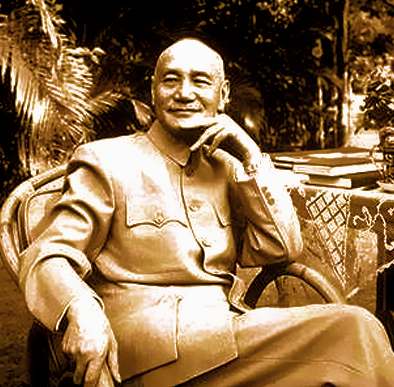
Chiang Kai-shek (1887 - 1975) |
|
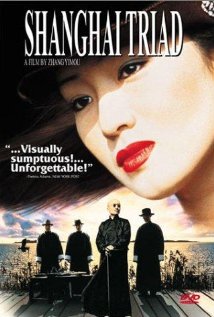 |
Movie Review
An epic tale of greed, revenge,
and lust for power set against the Shanghai opium wars of the 1930's. |
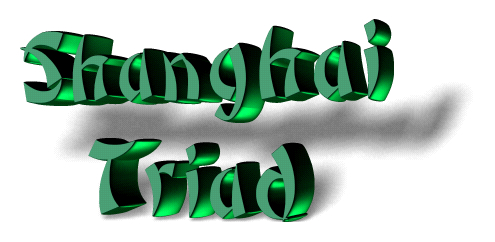 |
|
Shanghai Triad (1995)
Depicts the power struggles of the city’s criminal underworld through the
innocent eyes of a young country bumpkin employed to serve the mistress of
Shanghai’s top gangster. The film’s gang boss is based on
Du Yuesheng, a native son who rose through the ranks of the notorious Green
Gang to become the most powerful man in pre-Communist Shanghai. As for Gong Li,
who plays the gang lord’s glorified sing-song girl, she looks just like one of
those radiant “celestial” beauties depicted in Shanghai’s popular calendar art.
The most fascinating character is the silent, but ever watchful, country boy
whose dream of finding a better life in Shanghai becomes a cruel nightmare.
Shanghai
Triad
DVD by Sony Pictures
Language Mandarin
The DVD edition includes English and Spanish subtitles.
The DVD is in the widescreen letterbox format with an aspect ratio of 1.85:1.
Shanghai Triad Trailer |
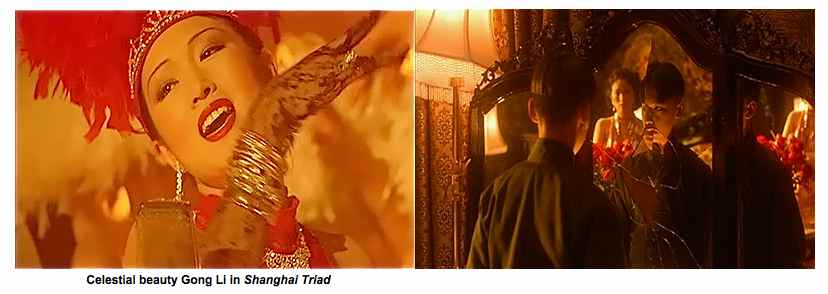 |
|
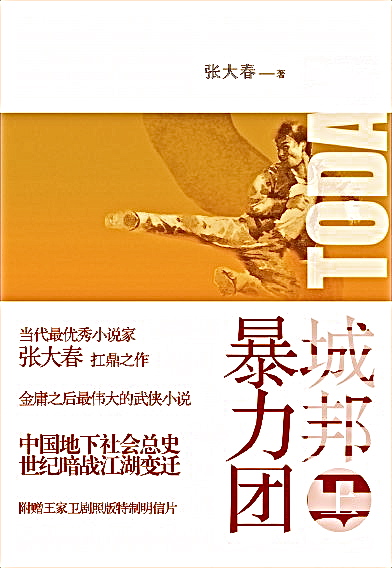 |

Book Review |
Gangsters of the City State
Hong Kong novelist Ni Kuang called it “the finest work of martial
arts fiction since Jin Yong.”
The work, which blends kung fu, mixed martial arts and underground
society into real-life Taiwan, tells of the dealings between criminal
gangs and Nationalist secret service agents during the 1949 retreat.
The story begins in 1965 with the death of the leader of Green Gang, a
secret society established in the Qing Dynasty (1644-1911). While the
details are rooted in history, Zhang takes considerable artistic
license.
This book takes place over three periods. The first dates back to Qing
Dynasty with the origin of the Green Gang; the second is when the
gangsters fight the Japanese during World War II and retreat to Taiwan;
and the third is about a young character discovering the secrets of
Taiwan’s history since the 1960s. |
|

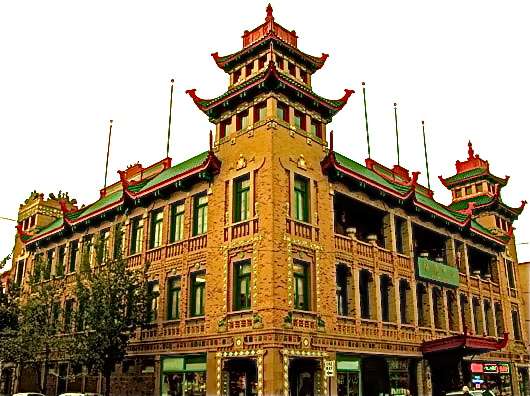
On Leong Merchants' Association Building in Chinatown Chicago
The building is a historic place in
Chicago's Chinatown; it is located at the address 2216 S. Wentworth Avenue,
Chicago, Illinois. On December 1993 it was designated a landmark by the
Commission of Chicago Landmarks
Excerpt -
Hung Society
|
|
The building was constructed from 1926
to 1928. Originally it was built for the On Leong Merchants Association, as it's
second South Side location, and was formerly also the headquarters of the
notorious "On Leong Tong". In 1992 the building was seized by the government
during a prosecution for gambling and became the Pui Tak Center in 1994.
Today, in most major North American cities which have a Chinatown it is possible
to find the headquarters of the tongs, themselves often branches of the Hung
society. To someone familiar with their names and able to read the Chinese
characters, these buildings are clearly marked. Many of them are quite elaborate
in their architecture.
It was only relatively recently in Chinese history, within the past five
hundred years or so, that relatively modern secret societies (distinct
from religious cults) became widespread. Although there was a great deal
of variation from time to time and place to place, these tended to
follow common, culturally prescribed patterns. |
|
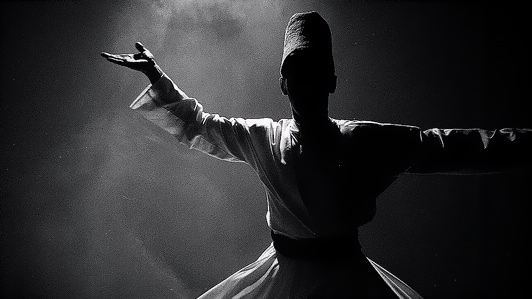 |
 |
|
Istanbul's Hidden Sufi Lodges |
|
The Banned Dervish Halls are
Scattered Through the City |
|
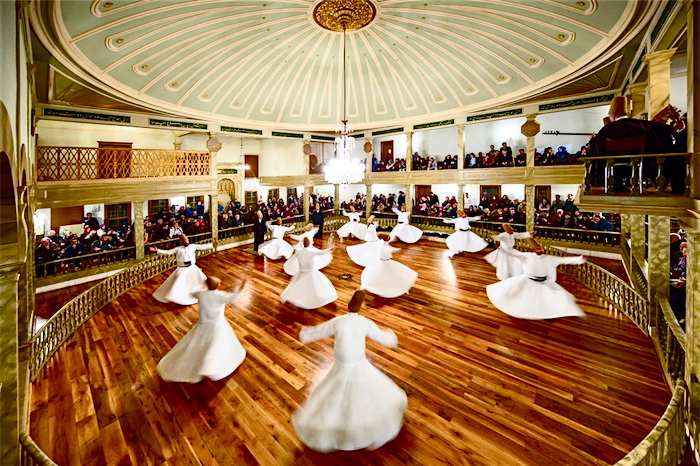 |
Whirling of the Mevlevi Dervishes - One of Turkey's most
iconic images, popularized in films and tourist ads for decades.
Naturally, these ads do not mention that it has been illegal to perform
this ritual for almost 100 years. In fact the Mevlevis are just one of a
dozen Islamic Orders—called 'Tarikat in Turkish', whose
activities are still banned in Turkey.
Luckily for tourists and Turks, selective application of the law means
that we can still watch the Mevlevis' whirling ceremony inside
state-owned museums. But for every lodge that has been turned into a
cultural center or museum, there are hundreds that lurk neglected and
crumbling in the backstreets.
The number of Istanbul's lodges reached around 700 in the Ottoman era.
Each of the orders that lived in these buildings had different rituals
and professions: the Mevlevis were musicians and artists, the Bektaşis
were soldiers, and the Nakşibendi were scientists, for example. Aside
from the 'Whirling Dervishes', European travelers in the 19th
century were spectators to the Rifaiyye “Howling Dervishes”, who
practiced flagellation and piercing with needles. Mustafa Kemal
Atatürk's - Vision of a republic based on European positivism had no
place for mystical orders. The outbreak of a southeastern rebellion led
by Nakşibendi leader Sheikh Said gave the government a reason to act,
and in 1925 all Sufi lodges and Ottoman tombs were closed by law. It
also became illegal to use the titles of “Sheikh”, “Dervish”, “Emir”,
and “Caliph”, to wear clothing associated with those titles, and
more bizarrely to call oneself a 'Coffee Reader, Sorcerer, or
Exorcist'. The first cracks in this extreme secularism came with the
defeat of Atatürk's party in the 1950 elections, and the Ottoman tombs
were reopened to the public that year—with no change to the ban on
Islamic Lodges. |
|
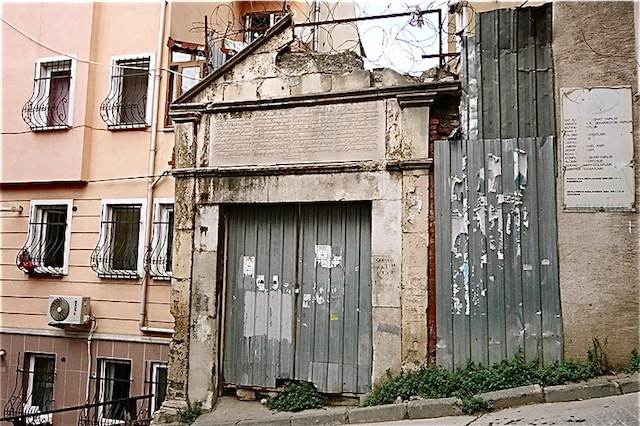 |
|
Entrance to Ruined Kasimpasa Mevlevihanesi |
Istanbul's First Lodge - Was founded next to Rumeli Hisarı,
the fortress that Sultan Mehmed I built in preparation for the conquest
of 1453. Now on the grounds of Boğaziçi University, the lodge was
rebuilt as a historical research center in 2015.
The Galata Mevlevihanesi, a two-minute walk from the Galata Tower, dates
to 1481 and reopened as a museum in 2011. While the building is
beautifully restored, the waxworks of cross-legged Sufis have all the
mystical power of a natural history museum. Visitors are invited to
watch the whirling ceremony every Sunday—as has been the case since the
19th century, with travelers such as Gustave Flaubert and Hans Christian
Andersen writing their accounts of the Dervishes. |
|
Inside Galata Mevlevihanesi |
Across the Bosphorus in Üsküdar, the 18th-century Uzbekistan Lodge
has met a worse fate. Bukharan pilgrims built the lodge as a stop on the
way to Mecca, but after the Ottoman defeat in World War I it began
ferrying Turkish nationalists in the opposite direction. Future
president İsmet İnönü was one of those who escaped the Allied occupation
of Istanbul through the Uzbeks. Atlantic Records co-founder Ahmet
Ertegün was descended from one of the lodge's Sheiks, and he restored it
in 1996 with the aim of opening a museum. Ten years later he signed the
lodge over to the government, and it has since been occupied by a
foundation for Islamic research.
In recent years a number of high-profile writers have revived interest
in the Sufi orders. Despite having no strong beliefs himself, Orhan
Pamuk used Sufi elements in his novels The Black Book (1990) and Snow
(2002). Popular writer Elif Şafak retold Mevlana’s relationship with
Shams of Tabriz in her novel The Forty Rules of Love (2010), and she has
talked widely about her respect for Sufism. However, neither Pamuk nor
Şafak have declared themselves as active members of a Sufi order. |
|
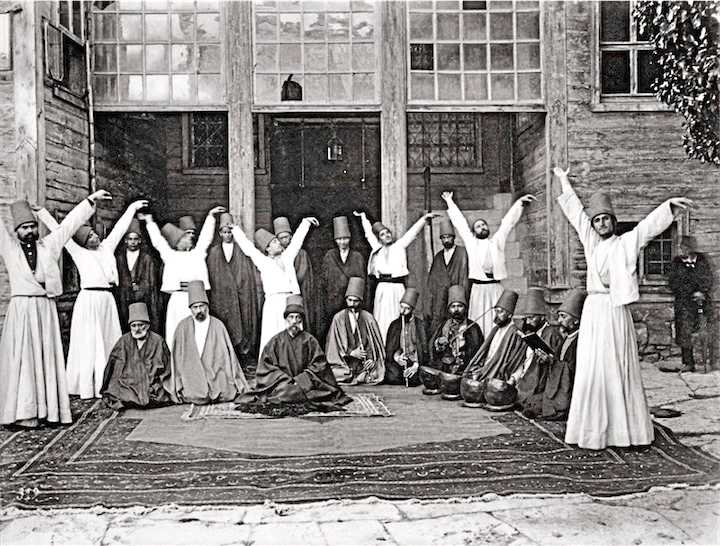 |
|
Outside Galata Mevlevihanesi in 1870 |
One symbol of continuity is the family of Mevlana Celalledin-i Rumi,
whose 22nd generation descendant still lives in Turkey as president of
the International Mevlana Foundation. President Faruk Hemdem Çelebi
represents an unbroken line of over 800 years from Rumi's birth to the
present day.
Public interest peaked recently with news of celebrities joining one of
Istanbul's Cerrahi lodges. The Nureddin Cerrahi lodge, close to the
Byzantine walls of the old city, contains the tomb where the order's
founder is buried, as well as a hall for zikir—remembrance of the names
of God through music and dance. Cerrahi members dress in white robes and
skullcaps with black jackets, rocking and turning to hymns accompanied
by the "Ney (Reed Flute), Tambur (Long-necked Lute), and Def (Frame
Drum)". Similar to the Nigns of Hasidic Jews, the rising tempo
carries the Cerrahis into an 'Ecstatic Union with the Divine'. |
|
Galata Mevlevihanesi Museum |
Also active in Istanbul is the Bektaşi Order - It is
considered a branch of Alevi Islam. Şahkulu Sultan Alevi-Bektaşi Lodge
is possibly the oldest Turkish structure on the Asian side of Istanbul,
built in 1329 by followers of Anatolian Mystic Hacı Bektâş-ı Velî. The
Bektaşis perform their Zikir mostly in Turkish, with few Arabic
words—a consequence of the strong Central Asian influence on Aleviism.
Unlike most Sunni groups, it is important for Alevis that men and women
perform these rituals together.
Since 2010 - Politicians from both the ruling party and the
opposition have proposed removing the 1925 law that closed the lodges.
But others are uneasy about approving these heterodox and eccentric
orders. Until a spirit of acceptance prevails, they will continue to
pass on their secrets in the twilight between past and present. |
|
The Secret Society of the African
Nyau |
The Nyau Brotherhood is a secret society of the Chewa people within
communities in Mozambique, Malawi and Zambia. Many local people,
including policemen, are afraid of the Nyau and consider them dangerous.
One sect of Nyau, known as 'Nyau Kampini' walk around with machetes and
have a reputation for attacking people. The Nyau are never prosecuted.
As a policeman indicates, "How can you put an elephant or snake in jail?
The same is with Nyau."
They have secret Signs and Passwords. If you pass a Nyau on the road and
use the hand sign, nothing bad will happen to you, as they will
understand you are one with them.
The Nyau wear masks and costumes that represent the 'Spirits of Animals'
called Nyama, and the Ancestors called Mizimu.
The Nyau keep both their rituals and their identity a closely guarded
secret. If an entire family is watching a Nyau dance, maybe the husband
will leave for a bit, then go to a secret place to change and enter the
dance. Later he will return so his mother, sister or wife won't know he
is a member. If a dancer falls down and injures himself and then limps,
all members of the Nyau will start rot limp so no one can identify the
injured dancer.
The Nyau perform the Gule Wamkulu ritual or "Great Dance" during the
harvest. They further perform at important ceremonies like weddings and
funerals. |
|
 |
|
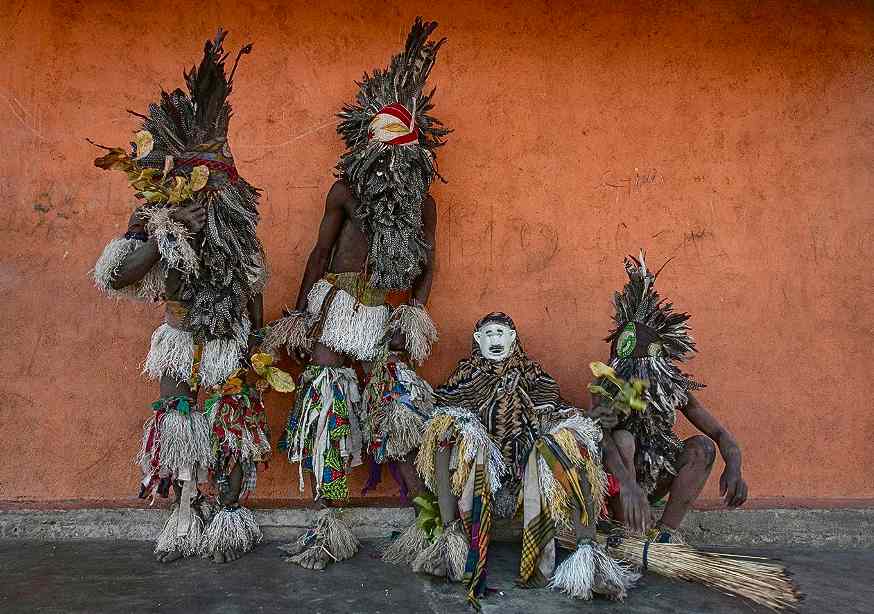 |
|
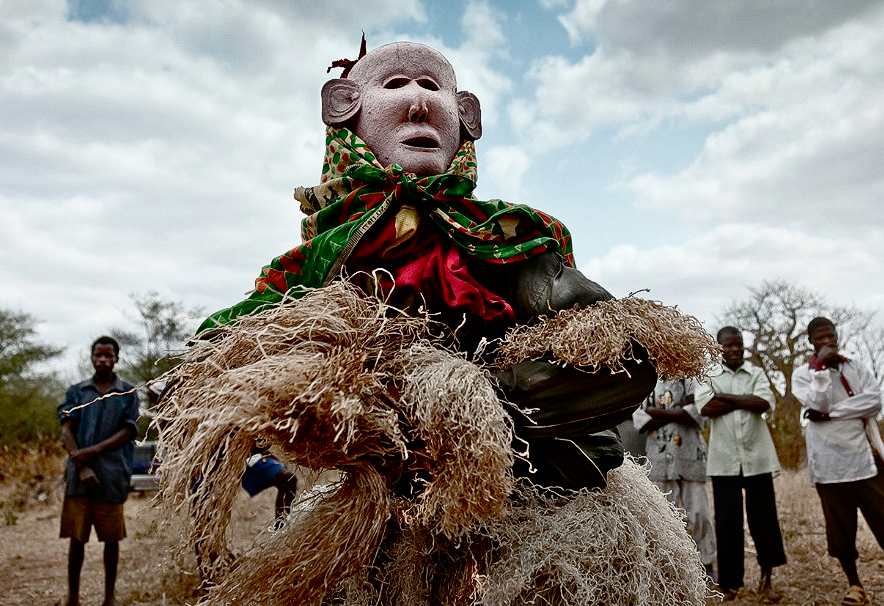 |
|
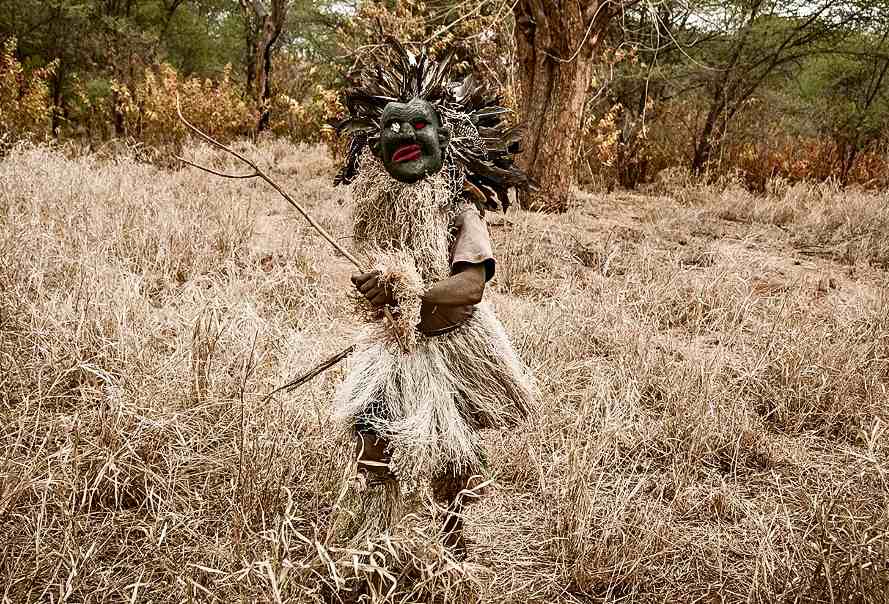 |
|
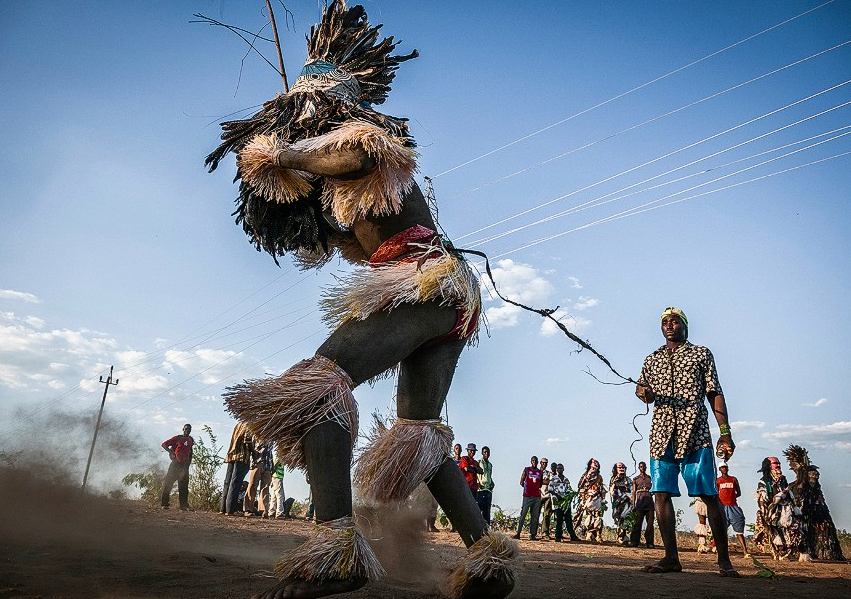 |
|
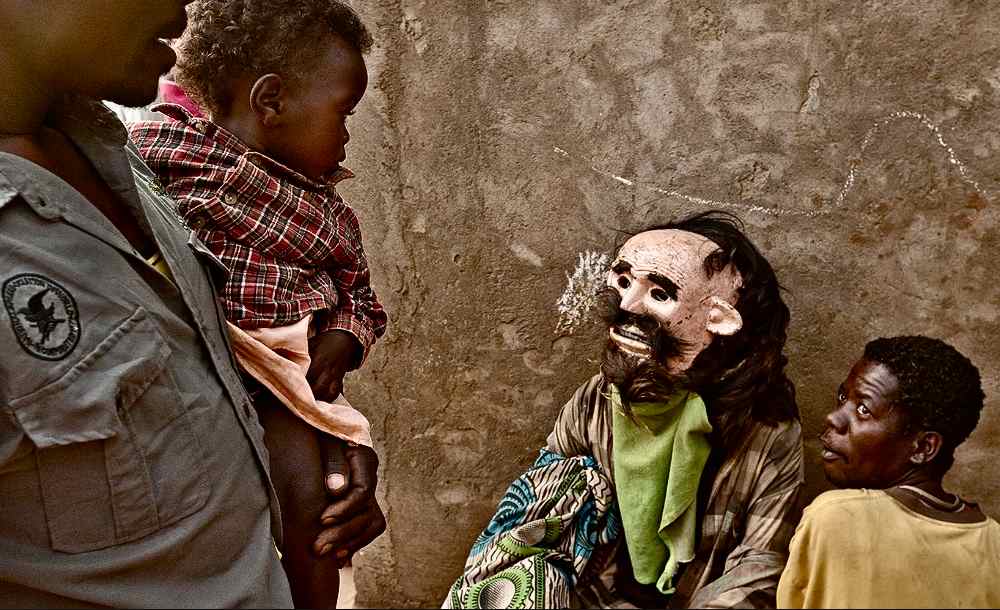 |
|
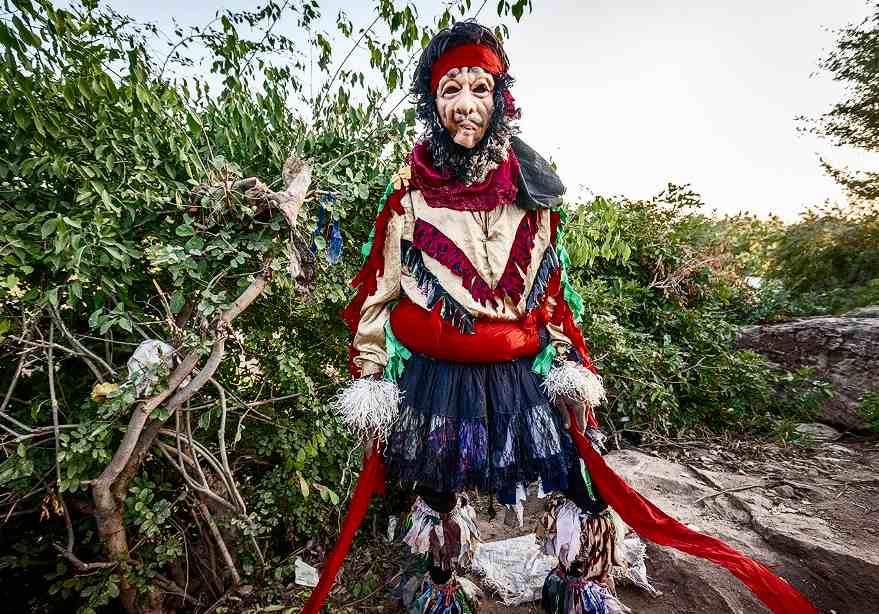 |
|
 |
|
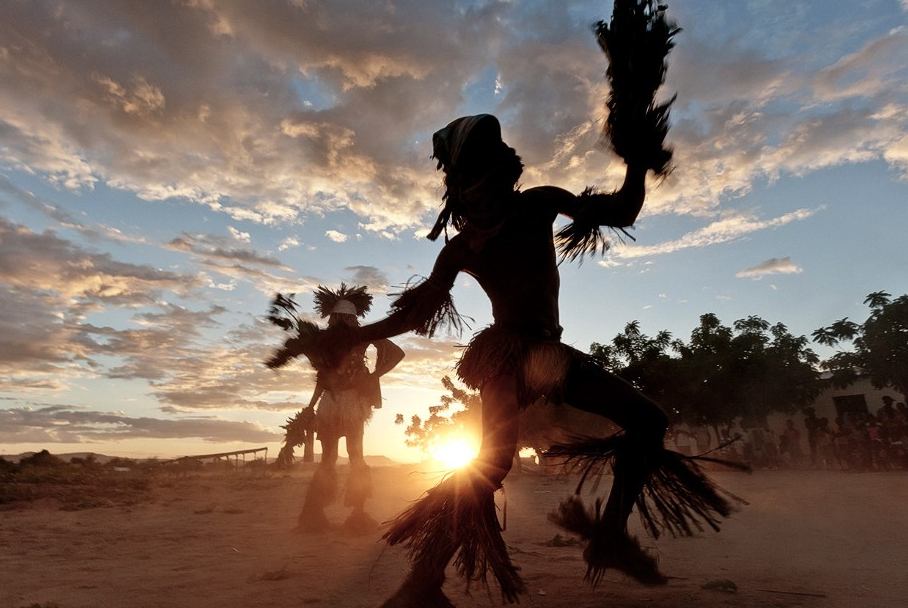 |
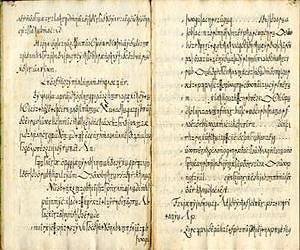 |
 |
US and Swedish researchers have cracked the code of the 300-year-old
Copiale Cipher with the help of a new computer program that may help to
decipher other legendary secretive manuscripts.
"This opens up a window for people who study the history of ideas and
the history of secret societies," computer scientist Kevin Knight of the
University of Southern California said.
"Historians believe that secret societies have had a role in
revolutions, but all that is yet to be worked out, and a big part of the
reason is because so many documents are enciphered." |
The 75,000-character
Copiale Cipher describes the rituals and
political leanings of an 18th-century German secret society, which bound
the manuscript in gold and green brocade paper, the USC statement said.
The rituals, encoded in a series of abstract symbols interspersed with
Greek and Roman characters, indicate that the secretive group had a
fascination with eye surgery but that members were not actually eye
doctors.
Knight's team initially thought the message was contained in the Greek
and Roman characters, but after the computer program disproved that
hypothesis, they shifted their attention to the abstract characters,
eventually translating the German words for "Ceremonies of Initiation"
and "Secret Section." |
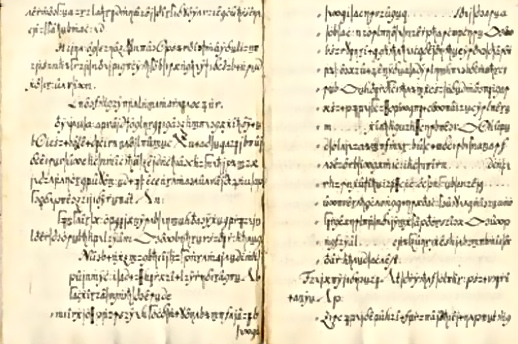 |
Knight plans to target other famous coded messages, including the
ciphers sent by the Zodiac Killer, an American serial murderer in the
1960s and early 1970s who sent cryptic messages to the press and has
never been caught.
He also wants to try the program out on "Kryptos," an encrypted message
carved on a sculpture at CIA headquarters, and the medieval Voynich
Manuscript, considered among the most mysterious manuscripts ever found. |
|
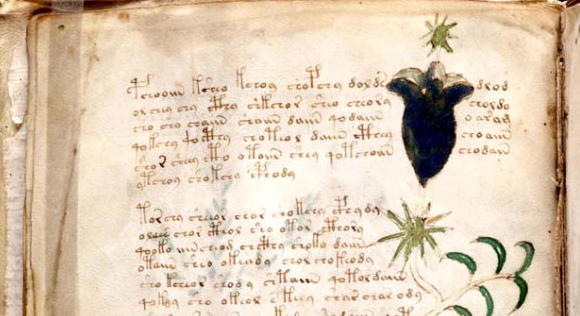
Voynich Manuscript |
|